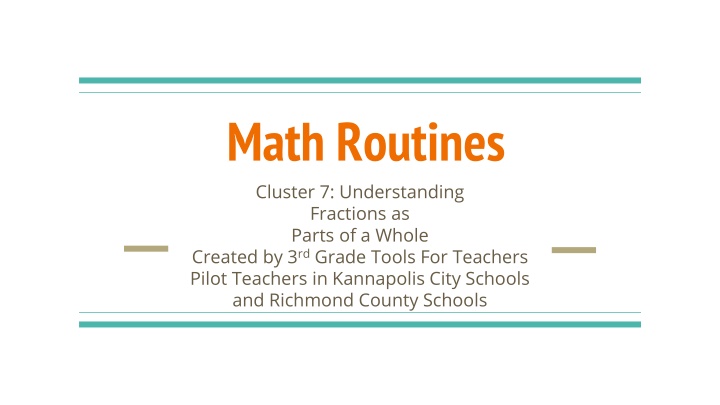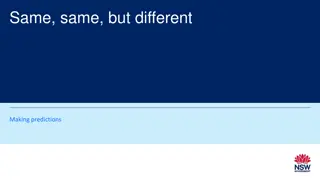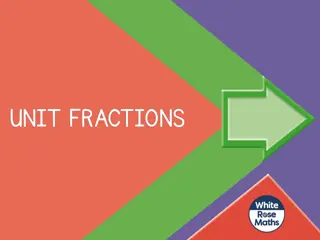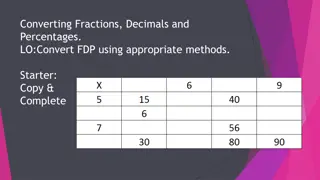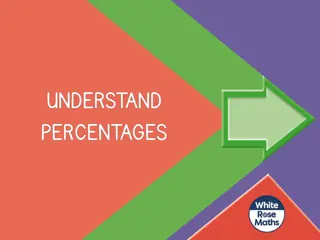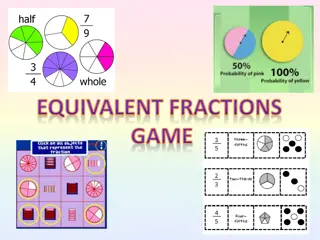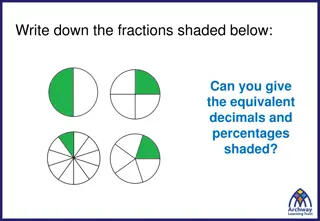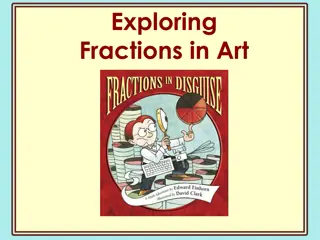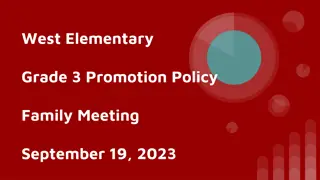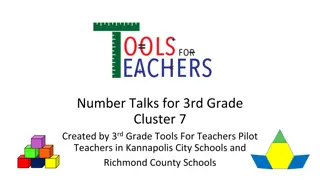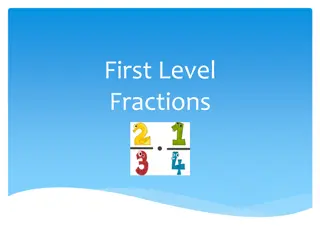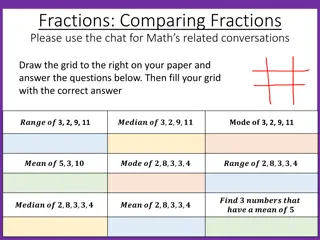Fractions in 3rd Grade Tools
Dive into the world of fractions with 3rd-grade tools for teachers in Kannapolis City Schools and Richmond County Schools. Understand fractions as parts of a whole, interpret unit fractions, represent equivalent fractions, compare fractions, and more. Engage in activities like Counting Around the Room and Would You Rather, enhancing your math skills in a fun and interactive way.
Download Presentation

Please find below an Image/Link to download the presentation.
The content on the website is provided AS IS for your information and personal use only. It may not be sold, licensed, or shared on other websites without obtaining consent from the author.If you encounter any issues during the download, it is possible that the publisher has removed the file from their server.
You are allowed to download the files provided on this website for personal or commercial use, subject to the condition that they are used lawfully. All files are the property of their respective owners.
The content on the website is provided AS IS for your information and personal use only. It may not be sold, licensed, or shared on other websites without obtaining consent from the author.
E N D
Presentation Transcript
Math Routines Cluster 7: Understanding Fractions as Parts of a Whole Created by 3rdGrade Tools For Teachers Pilot Teachers in Kannapolis City Schools and Richmond County Schools
Standards NC.3.NF.1 NC.3.NF.2 NC.3.NF.3 NC.3.NF.4 Interpret unit fractions with denominators of 2, 3, 4, 6, and 8 as quantities formed when a whole is partitioned into equal parts; Explain that a unit fraction is one of those parts. Represent and identify unit fractions using area and length models. Interpret fractions with denominators of 2, 3, 4, 6, and 8 using area and length models. Using an area model, explain that the numerator of a fraction represents the number of equal parts of the unit fraction. Using a number line, explain that the numerator of a fraction represents the number of lengths of the unit fraction from 0. Represent equivalent fractions with area and length models by: Composing and decomposing fractions into equivalent fractions using related fractions: halves, fourths and eighths; thirds and sixths. Explaining that a fraction with the same numerator and denominator equals one whole. Expressing whole numbers as fractions, and recognize fractions that are equivalent to whole numbers. Compare two fractions with the same numerator or the same denominator by reasoning about their size, using area and length models, and using the >, <, and = symbols. Recognize that comparisons are valid only when the two fractions refer to the same whole with denominators: halves, fourths and eighths; thirds and sixths.
Count Around the Room Starting with one classmate, skip count by twos. Make sure to pay attention and count in your head as each person says their number. I will record the numbers on the board.
Count Around the Room Starting with one classmate, skip count by threes. Make sure to pay attention and count in your head as each person says their number. I will record the numbers on the board.
Count Around the Room Starting with one classmate, skip count by fours. Make sure to pay attention and count in your head as each person says their number. I will record the numbers on the board.
Would You Rather... .have 1 2of a cookie? or have 1 4of a cookie? Support Your Answer
Would You Rather... ...have 2 3of a cake? or have 3 3of a cake? Support Your Answer
Would You Rather... ...have 2 8of your room to clean? or have 2 4of your room to clean? Support Your Answer
Would You Rather... ...have spent 3 8of your money? or have 5 8of your money? Support Your Answer
Eliminate It! Which can be eliminated. Why? 3 2 3 4 1 3 3 5
Eliminate It! Which can be eliminated. Why? 2 3 6 8 3 3 1 3
Eliminate It! Which can be eliminated. Why? 4 8 3 8 2 4 3 6
Target Number: Find as many representations as you can. 1 2
Target Number: Find as many representations as you can. 2 3
Target Number: Find as many representations as you can. 4 6
Target Number: Find as many representations as you can. 8 8
Number Line 0 1 Where is a half on the number line? Why?
Number Line 0 1 Can you place four fractions on this number line?
Number Line 0 1 What fractions could be placed on this number line?
Number Line 3 4 What fractions could be placed on this number line?
Close, Far, In Between 1 2 4 4 0 Which two are closest? Why? Name a fraction between 0 and 1 2. Name a fraction between1 . 2and 4 4.
Close, Far, In Between 7 8 1 8 2 8 Which two are the farthest? Why? Name a fraction between 2 8and 7 8. How many unit fractions are between1 8and 2 8.
Close, Far, In Between 2 6 2 8 2 3 Which two are the closest? Why? Name a fraction between 2 6and2 3. How many unit fractions are between1 8and 2 8.
